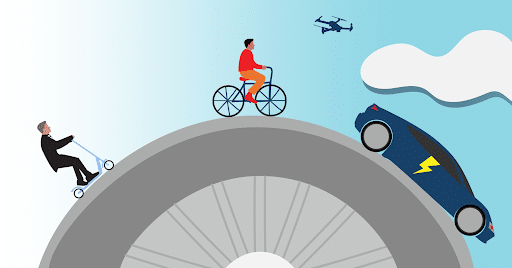Micro-mobility?
Although you might not yet be familiar with the term, it’s likely that you are already part of the micro-mobility revolution taking place in nationwide urban cities. Micro-mobility typically refers to small, light-weight vehicles, such as eBikes and eScooters, usually used for short distances. (And by short, we’re talking less than five miles.) As cities around the world swell in population, micro-mobility options have become necessities for commuters—and can also be thriving revenue streams for parking asset owners.
The rise of micro-mobility has been bolstered by 21% according to a Mckinsey Consumer Survey (between private and shared micro-mobility options). In part by commuters who have grown tired of traditional forms of public transportation, such as buses and trains. Many commuters are opting for quicker, easier, more convenient modes of transport. As cities struggle to cope with traffic, overcrowding, and emission controls, it’s no surprise that shared bicycle and scooter stands are popping up on every corner as eco- and time-friendly options.
Interestingly, micro-mobility services have been shown to increase access to public transportation modes, reducing the overall number of cars on the road. This positive trend simultaneously shrinks our environmental footprint while providing much-needed relief for inner-city congestion.
The current COVID crisis has led to new concerns over the safety and health of riding on public transit. The fact that most micro-mobility options are single-rider, open-air alternatives is an undeniable selling point. Bikes and scooters offer safer transportation methods as riders retain control of their social-distancing. Reducing the frequency of interpersonal contacts as they travel from point A to point B also helps to slow the spread while traveling through the busy city streets.
“Elevating smart parking systems with the added advantages of a mobility hub allows owners and operators to maximize every square foot of their parking portfolios while supplying a valuable service to the community.”
How Big Is The Micro-Mobility Market?
Current projections show that an additional 2.5 billion people worldwide will reside in urban areas by 2050. Yet cities are struggling to keep up with demand without being crippled by endless gridlock, overcrowding, and pollution. Micro-mobility options have proven to be socially, economically, and environmentally beneficial locally and globally.
As a result of the public’s understanding and demand for new transportation options, the micro-mobility market shows incredible growth. In the United States, the micro-mobility market is predicted to be worth more than $200B, and is expected to balloon to a value of $300B by 2030. There have been more than $5.7B in micro-mobility startup investments in the last five years alone, clearly demonstrating that we are only at the beginning of this new paradigm shift in how city dwellers view their transportation options.
The top players in the eScooter game have shown themselves to be incredible investment opportunities. For example, Bird spun investors’ heads worldwide when, in 2017, it became the fastest company to reach a $1B valuation—a mere nine months after it was founded. Within four months of reaching this momentous milestone, Bird then doubled its valuation to $2B, and it continues to acquire other micro-mobility startups such as Scoot and Circ.
Bird’s largest competition, Lime, offers shared bicycles in addition to scooters, and has recently reached a valuation of $2.4B. In May 2020, Lime acquired Uber’s bike-sharing business as well. Seeing that the U.S. was the first country to have dockless eScooters on city streets, it’s no surprise that the competition between big players in micro-mobility is racing forward at a fast and furious pace.
When companies like Bird first dispatched hundreds of scooters at a time to major cities across the country in 2017, it took the public and city officials some time to warm up to the new idea. Now, a few years into the micro-mobility movement, dockless scooter rentals have become as commonplace as hailing an Uber or Lyft, seamlessly integrating micro-mobility into daily life. The same can be said of shared bicycle programs, although they currently remain less popular than eScooters.

How Can My Parking Asset Benefit From Micro-Mobility?
As micro-mobility becomes the norm in modern urban life, being able to quickly and reliably find the transportation needed at any given time is an incredibly valuable asset. Elevating smart parking systems with the added advantages of also being a mobility hub allows owners and operators to maximize every square foot of their parking portfolios while supplying a valuable service to the community.
FlashParking’s intelligent system goes beyond mere occupancy-monitoring to better understand and serve new and existing customer bases. Accessing and fulfilling multiple micro-mobility needs in a single, regular location is a great convenience. Riders gain peace of mind and a feeling of safety when conducting their business in a secure, well-lit area. The ease of access to a centralized location also alleviates the burden of crowded city sidewalks, littered with discarded bikes and scooters.
Through FlashParking’s revolutionary management system, asset owners can virtually partner with an expanding roster of affiliated companies to utilize and revitalize their lots and garages. Our parking solutions enable the profitable conversion of underutilized space into micro-mobility hubs. By offering entirely new services, such as docking and charging stations, along with eScooter pickup and dropoff, parking garages become a thriving nucleus of activity for those who might not own a car—a demographic seemingly out of reach before now. Attracting consumers into your garage, regardless of why, offers new revenue opportunities.

Expand Your Offerings For An Integrated Consumer Experience
By multiplying the range of relevant offerings, it’s entirely possible to increase both the value and amount of services rendered per customer. For example, a driver might park their electric car in the lot, plug it into a charger for when they are at work, and then rent an eScooter to take them the last mile to their office. Offering a full circuit of useful commuter tools under one roof solidifies your garage as a cornerstone of the urban commuting experience. It gives consumers the seamless experience that they expect in today’s tech-driven world.
“Offering a full circuit of useful commuter tools under one roof solidifies your garage as a cornerstone of the urban commuting experience.”
As asset owners struggle to find and maintain their place in today’s rapidly evolving commuter marketplace, partnering with micro-mobility companies opens new doors and exposes an entirely new palette of potential revenue streams. Parking lot owners should expect more from their investments than a passive lot that can only turn a profit during regular business hours. By expanding your lot’s capabilities to include ride-share staging, fleet services, and food truck courts during off-hours, previously underutilized space transforms into a profitable alternative. These new opportunities serve both asset owners and the community.
The addition of a micro-mobility hub to your existing parking asset will diversify and future-proof your revenue streams, and become a profitable advantage as we move towards the cityscape of the future. This incredible opportunity is available to you now through FlashParking’s innovative suite of smart parking solutions.
Curious about how mobility hubs work?
Join leading mobility innovators from EVBox and Flash in a lively on-demand webinar discussion about how you can take advantage of new mobility to drive and diversify revenue. Sign-up now:

